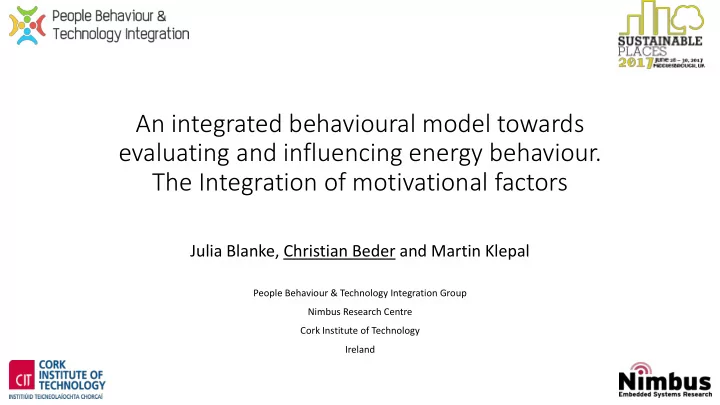

An integrated behavioural model towards evaluating and influencing energy behaviour. The Integration of motivational factors Julia Blanke, Christian Beder and Martin Klepal People Behaviour & Technology Integration Group Nimbus Research Centre Cork Institute of Technology Ireland
Demand response valu lue chain in Development Cross Cross Technology Cross Design Integrator Commodity Other Markets Commodity Provider Commodity …. Operator Primary Producer Energy Elec. Provider Heat/Cool Subscriber Occupant Gas, Coal Water… / Facility Elec. / End-User Manager Demand Response Demand
Addit itional valu lue created by y dyn ynamic BDR Development Cross Cross Technology Cross Design Integrator Commodity Other Markets Commodity Provider Commodity …. Operator Primary Producer Energy Elec. Provider Heat/Cool Subscriber Occupant Gas, Coal Water… / Facility Elec. / End-User Manager Prosumer Flexibility Classical Behaviour Demand Demand Response Behaviour Demand Response Classical Demand
How to approach dyn ynamic behaviour demand response? • Awareness campaigns and smart meters? • Incentive schemes and dynamic tariff structures? • Send dynamic information messages to consumers? • Create social involvement and gamification? This is all fine, but… • Can we approach the problem in a more structured way? • Can we apply existing behavioural models to this problem domain? • Can we even integrate these models into energy system optimisation?
Our approach: Look at establi lished behavioural theories
What do we get from these behavioural theories? • Each theory identifies relevant behavioural variables and parameters and their mutual relations • There is a useful body of research providing us with validated techniques for measuring behavioural variables • This approach lends itself to Bayesian modelling, allowing to predict behavioural parameters of individuals based on fused measurements • Model-driven estimation of behavioural parameters allows the integration of building occupants into the energy optimisation processes as reliable flexibility assets • Model-driven interaction design aims at targeting the right person, with the right message, at the right time and location
Example: maximising the individual’s in intention to act ct
Example: optimis ising for type of motiv ivation
Summary and conclusion • Behavioural modelling is a useful tool for energy optimisation • It provides a rigorous approach based on an existing large body of research for measuring and estimating behavioural variables and parameters • It explains many reasons why certain ad-hoc approaches work, but it allows to go further and integrate these techniques into a common framework • It allows for optimisation and integration with physical asset models • It can be used to integrate building occupants as reliable flexibility assets into the energy optimisation processes • It can be used to optimise the interactions with energy prosumers
Thank you for your attention. People Behaviour & Technology Integration Group Nimbus Research Centre Cork Institute of Technology Ireland http://nimbus.cit.ie/people-behaviour-research/
Recommend
More recommend